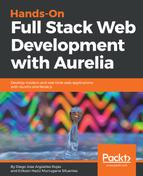Your knowledge about Aurelia at this moment is just amazing! We wanted to cover every aspect regarding component creation and how you can abstract your business scenario into one digital application. You learned that each component is part of an everything, is reusable, and allows you to separate your application concerns. Since a component is an isolated piece of your application, it manages his own life cycle; Aurelia allows us to have complete control and configure events such as data loading or some custom behavior when the components is destroyed. Another very interesting thing is that we can create our own events, and we can trigger them from the view layer.
Also, you must remember that one component can inherit from other components, and they all have properties. Remember that Aurelia is a double-way binding framework, so all these properties are synchronized between the view and view model files. We also learned how to implement value-converters and some other binding behavior to improve our application performance and reduce the amount of code, making our application more lightweight and maintainable. Once our components are created and we have our application scenarios, it's time to link all of them through dynamic routing, defining user workflows and passing dynamic properties to each template. Last but never least, we went through how to test our application components, ensuring their functionality and life cycle behavior.
You can start creating components and exploring the Aurelia Materialize's library to customize your application. In subsequent chapters, you will find our app very advanced, but don't worry, there won't be anything we haven't explained. Keep practicing!
